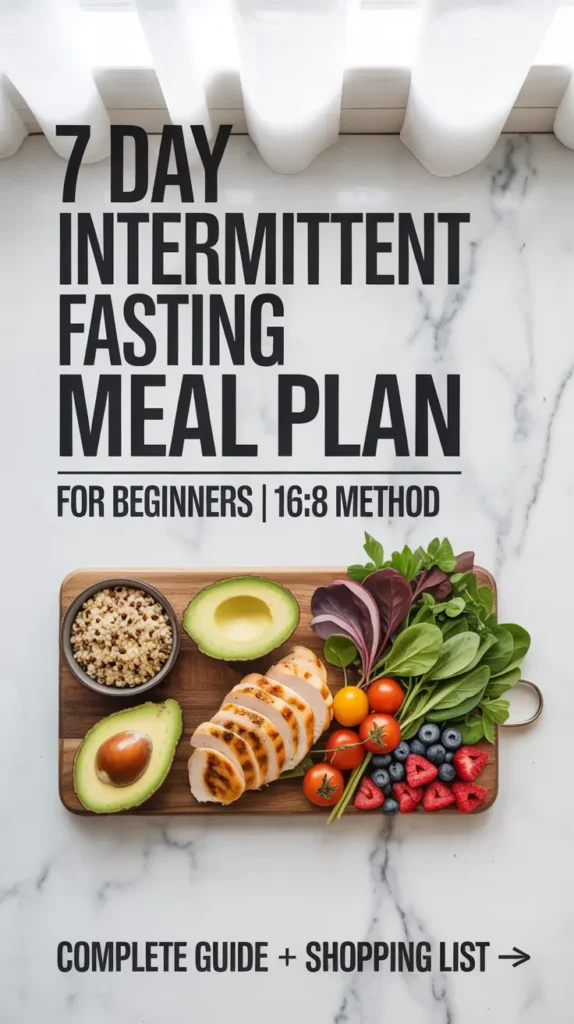Intermittent fasting (IF) is a way of eating that switches between eating and not eating. You don’t change what you eat – you change when you eat. Think of it like giving your body a break from food for certain hours each day. Here we explain the 7 Day Intermittent Fasting Meal Plan for Beginners to try.

The most popular method is called 16:8. This means:
- You fast for 16 hours
- You eat during an 8-hour window
- Example: Eat from 12 PM to 8 PM, then fast until 12 PM the next day
Why Try Intermittent Fasting?
Health Benefits:
- May help with weight loss
- Can improve blood sugar levels
- Might boost brain function
- Could reduce inflammation
- May increase energy levels
Lifestyle Benefits:
Take Charge of Your Health with The Home Doctor
Discover real-world remedies and first-aid solutions you can use when help isn’t around.
👉 Claim Your Home Doctor Guide- Saves time on meal prep
- Reduces decision fatigue about food
- Can save money on groceries
- Fits busy schedules easily
Getting Started: Choose Your Schedule
Popular IF Schedules for Beginners
| Method | Eating Window | Fasting Period | Best For |
|---|---|---|---|
| 16:8 | 8 hours | 16 hours | Most beginners |
| 14:10 | 10 hours | 14 hours | Easier start |
| 18:6 | 6 hours | 18 hours | More experienced |
| 12:12 | 12 hours | 12 hours | Complete beginners |
Start with 12:12 or 14:10 if you’re new to fasting!
7-Day Meal Plan (16:8 Method)
Eating window: 12 PM – 8 PM
Day 1: Monday
Meal 1 (12 PM – Lunch)
- Grilled chicken salad with mixed greens
- 1/2 avocado
- Cherry tomatoes
- Olive oil dressing
- 1 slice whole grain bread
Snack (3 PM)
- Apple slices with 2 tbsp almond butter
Meal 2 (6 PM – Dinner)
- Baked salmon (4 oz)
- Roasted sweet potato
- Steamed broccoli
- Side salad with lemon dressing
Evening Snack (7:30 PM)
- Greek yogurt with berries
Day 2: Tuesday
Meal 1 (12 PM – Lunch)
- Turkey and hummus wrap
- Whole wheat tortilla
- Lettuce, cucumber, bell peppers
- Side of baby carrots
Snack (3 PM)
- Mixed nuts (1/4 cup)
- Orange slices
Meal 2 (6 PM – Dinner)
- Lean beef stir-fry
- Brown rice (1/2 cup)
- Mixed vegetables
- Sesame oil for cooking
Evening Snack (7:30 PM)
- Cottage cheese with cucumber
Day 3: Wednesday
Meal 1 (12 PM – Lunch)
- Quinoa bowl with chickpeas
- Roasted vegetables
- Feta cheese
- Tahini dressing
Snack (3 PM)
- Banana with 1 tbsp peanut butter
Meal 2 (6 PM – Dinner)
- Grilled chicken breast
- Baked potato with skin
- Green beans
- Small side salad
Evening Snack (7:30 PM)
- Handful of berries
Day 4: Thursday
Meal 1 (12 PM – Lunch)
- Tuna salad on whole grain bread
- Side of cherry tomatoes
- Pickle spear
- Small bag of baked chips
Snack (3 PM)
- Celery sticks with cream cheese
Meal 2 (6 PM – Dinner)
- Baked cod with herbs
- Wild rice pilaf
- Roasted Brussels sprouts
- Lemon wedge
Evening Snack (7:30 PM)
- Small handful of almonds
Day 5: Friday
Meal 1 (12 PM – Lunch)
- Buddha bowl with tofu
- Quinoa base
- Roasted vegetables
- Avocado slices
- Soy sauce dressing
Snack (3 PM)
- Pear with string cheese
Meal 2 (6 PM – Dinner)
- Grilled pork tenderloin
- Mashed cauliflower
- Sautéed spinach
- Dinner roll
Evening Snack (7:30 PM)
- Greek yogurt with honey
Day 6: Saturday
Meal 1 (12 PM – Lunch)
- Egg salad sandwich
- Whole grain bread
- Side of grape tomatoes
- Pretzels
Snack (3 PM)
- Trail mix (2 tbsp)
Meal 2 (6 PM – Dinner)
- Baked chicken thighs
- Roasted root vegetables
- Quinoa
- Green salad
Evening Snack (7:30 PM)
- Dark chocolate square (70%+)
Day 7: Sunday
Meal 1 (12 PM – Lunch)
- Smoothie bowl
- Banana, berries, protein powder
- Granola topping
- Coconut flakes
Snack (3 PM)
- Hummus with veggie sticks
Meal 2 (6 PM – Dinner)
- Lean ground turkey meatballs
- Zucchini noodles
- Marinara sauce
- Side of garlic bread
Evening Snack (7:30 PM)
- Herbal tea with a small cookie
Food Lists for Easy Planning
Protein Sources
- Chicken breast
- Fish (salmon, cod, tuna)
- Lean beef
- Turkey
- Eggs
- Greek yogurt
- Cottage cheese
- Tofu
- Beans and lentils
Healthy Carbs
- Sweet potatoes
- Brown rice
- Quinoa
- Whole grain bread
- Oats
- Fruits
- Vegetables
Healthy Fats
- Avocado
- Nuts and seeds
- Olive oil
- Fatty fish
- Nut butters
Vegetables (Eat Lots!)
- Leafy greens
- Broccoli
- Bell peppers
- Carrots
- Tomatoes
- Cucumber
- Zucchini
- Brussels sprouts
What to Drink During Fasting
Allowed During Fasting Hours:
- Water (drink lots!)
- Black coffee
- Plain tea (green, black, herbal)
- Sparkling water
- Water with lemon
Avoid During Fasting:
- Anything with calories
- Juice
- Soda
- Coffee with cream/sugar
- Sports drinks
Beginner Tips for Success
Week 1: Start Slow
- Begin with 12:12 fasting
- Focus on staying hydrated
- Don’t worry about perfect meals
- Listen to your body
Common Mistakes to Avoid
- Eating too much during eating window
- Not drinking enough water
- Starting with long fasts
- Ignoring hunger signals
- Skipping meals completely
How to Handle Hunger
- Drink water first
- Keep busy during fasting hours
- Remember hunger comes in waves
- Start with shorter fasts
- It gets easier after week 1
Sample Shopping List
Proteins
- Chicken breast (2 lbs)
- Salmon fillets (1 lb)
- Ground turkey (1 lb)
- Eggs (1 dozen)
- Greek yogurt (large container)
- Cottage cheese
Fruits & Vegetables
- Mixed salad greens
- Broccoli
- Sweet potatoes
- Avocados (3-4)
- Bananas
- Apples
- Berries
Pantry Items
- Brown rice
- Quinoa
- Whole grain bread
- Olive oil
- Nuts and nut butter
- Beans/lentils
When to Eat Your Meals
Sample Daily Schedule (16:8)
| Time | Activity |
|---|---|
| 6:00 AM | Wake up, drink water |
| 7:00 AM | Black coffee or tea |
| 10:00 AM | More water, stay busy |
| 12:00 PM | First meal (lunch) |
| 3:00 PM | Healthy snack |
| 6:00 PM | Main meal (dinner) |
| 7:30 PM | Light snack if needed |
| 8:00 PM | Fasting begins |
Tracking Your Progress
What to Monitor
- Energy levels
- Sleep quality
- Hunger patterns
- Weight (optional)
- How you feel
Weekly Check-ins
- Are you feeling energized?
- Is the schedule working for you?
- Do you need to adjust timing?
- Are you enjoying your meals?
Safety and Important Notes
Who Should Avoid IF
- Pregnant or breastfeeding women
- People with diabetes (consult doctor)
- Those with eating disorder history
- Children and teenagers
- People on certain medications
When to Stop
- If you feel dizzy or weak
- If you can’t concentrate
- If you’re losing weight too fast
- If you’re not sleeping well
- If it’s affecting your mood badly
Always talk to your doctor before starting any new eating plan.
Making It Work Long-term
Flexibility is Key
- Adjust your eating window for social events
- Don’t stress about perfect timing
- Focus on nutritious foods
- Make it fit your lifestyle
Build Healthy Habits
- Plan your meals ahead
- Keep healthy snacks ready
- Stay hydrated
- Get enough sleep
- Exercise regularly
Final Tips for Success
- Start gradually – Don’t jump into long fasts
- Stay hydrated – Water is your best friend
- Plan your meals – Preparation prevents poor choices
- Be patient – It takes time to adjust
- Listen to your body – It knows what it needs
Remember, intermittent fasting is not a magic solution. It’s a tool that works well with healthy eating and regular exercise. The key is finding a pattern that fits your life and makes you feel good.
Your journey to better health starts with one meal at a time. Be kind to yourself, stay consistent, and celebrate small wins along the way!

Sandra Hernandez, a resident of New York, is an active contributor on lifebing.com. Her passion for knowledge fuels her writing journey as she delves into fascinating topics that capture her curiosity.
